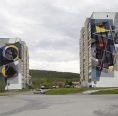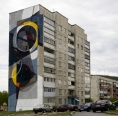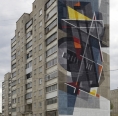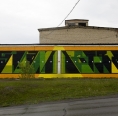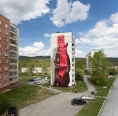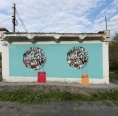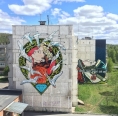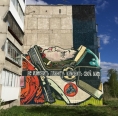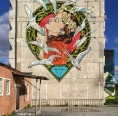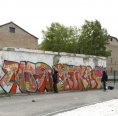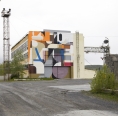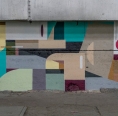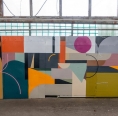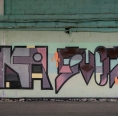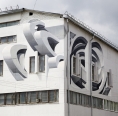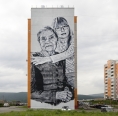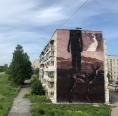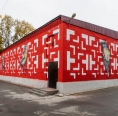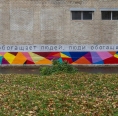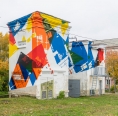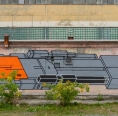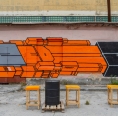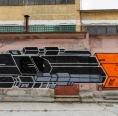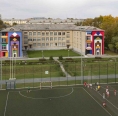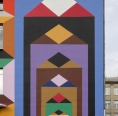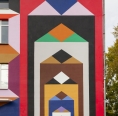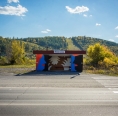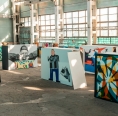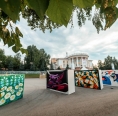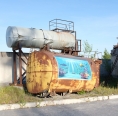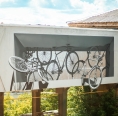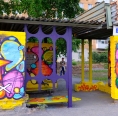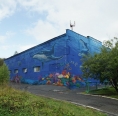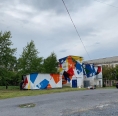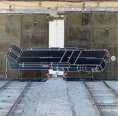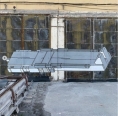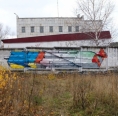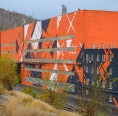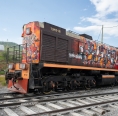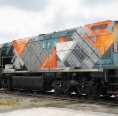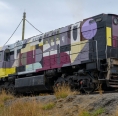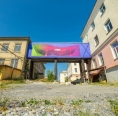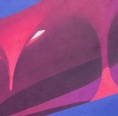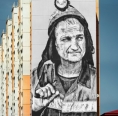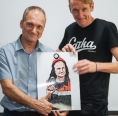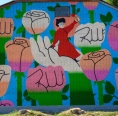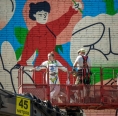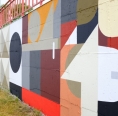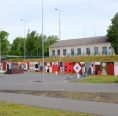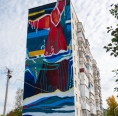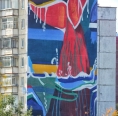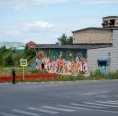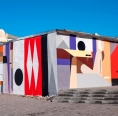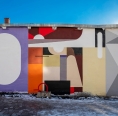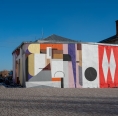-

Satka Street Art Festival
International Festival of Street Art
"Satka Street Art Fest" is the international street art festival introduced in 2017 by «Sobranie» Fund, Magnesite Group and Satka District Administration.
The city has become an open-air gallery, with building facades being the canvases and the collection comprising the works of the most popular, world-famous artists. In fact, Satka can be called the center of street art on a global basis - it was attended by artists from Russia, Switzerland, Italy, Germany, Holland, Spain and RSA. Coming from different countries, they share their native culture and outlook with local citizens who get an opportunity to be the spectators and participants of this colorful visual journey.
2017
Satka Street Art Festival, the First International Festival of Street Art, came to an end in Satka (the Chelyabinsk Region). This event was supported by Pro Helvetia Swiss Arts Council and Istituto Italiano di Cultura in Moscow. The Festival showed the example of urban environment transformation, pushed development of creative potential of young people. Five graffiti works created by three duets of artists – Russian Aesthetics group, Swiss Nevercrew and Italian SOLO & DIAMOND – were solemnly presented to the public June 20.
Facades of very common residential houses in Satka’s Zapadny District ended up in the crosshairs of masters.Two bright abstract images made by the Russian team of artists Petr Gerasimenko (Petro) and Ilya Blinov (Slak) from Aesthetics Group united nature and industrial culture of Satka. Geometry of the compositions built a la classical masters of the Russian avant-garde delivers the idea of blending of two beginnings, the most harmonious moments of the interface of human activities focused on space urbanization, and the nature, with its unharnessed energy and vulnerability.
The goal pursued by the authors is the picturesque essence of the things they observed in Satka. The more interesting it is that in the images many people recognized echoes of the city’s sculptural milestone – hammer and sickle in the background of the five-pointed star.
Graffiti of the Italian artists, Flavio Corbonaro (Solo) and Stefano Biagiotti (Diamond) feature their own technique and style. Stefano Biagiotti created the female image surrounded by swans explaining that he was inspired to this artistic concept by wonderful Russian cartoons broadcasted on the Italian TV several years ago, which he liked very much. That is why he devoted his work to Wild Swans fairy-tale. Simona Kapodimonte, an Italian coordinator of the project, finds that the female character depicted in the painting refers to the queen of swans from the famous Swan Lake of Pyotr Tchaikovsky.
Wall painting of Flavio Corbonaro shows a spaceman. The painter created this image as a tribute to the important stage of the Russian history – history of space exploration. Another idea that contributed to his choice, as explained by the painter, was Satka having a special connection with the outer space.
"I usually paint super heroes or book / comics characters. But this time I chose an astronaut as the tribute to the important page in Russian history, – Flavio Corbonaro comments. – Words in the picture, Don’t change the planet, do change your world, are an insightful message. First of all, an environmental one. Russia is a surprising place, and what world it will be here depends on the people who live here.
Nevercrew, a duet of Swiss artists – Christian Rebecchi & Pablo Togni – created a 3D painting: a huge, lifelike bear leaned against the wall of nine-storeyed house. The work reflects the painters’ traditional approach to the theme of interconnection between the mankind and the nature, when the nature suffers from effects of human impact, while the human does not or prefers not to see what is going on. The image of brown bear is chosen on purpose: its population in Russia is one of the largest in the world, it is not endangered, and the authors consider it to render close connection with nature. According to the artists’ concept, the red ribbon that covers the bear is appeal to understanding responsibility for environmental impact of people.
- In addition to the brown bear, the red colour takes a lot of space in the composition. It reminds the warning, signal of being aware of a possible hazard. The project follows our customary approach to the relations between mankind and nature, where nature, as a rule, suffers from consequences of the policy and habits of the mankind, – the project authors told.
Another painting related with the theme of man / nature interaction was created by the authors in the infrastructure site located close to waste dumps formed while extracting magnesite raw material.
For the time of the festival, Satka became not only an international creative art workshop, but also a shooting area. Students of Gerasimov’s All-Russian State Institute of Cinematography were shooting the documentary of the work of every of the three teams. The students’ supervisor is Sergey Valentinovich Miroshnichenko, Russian documentary film maker, Honoured Artist of Russia. Young film-makers will unite the three stories in a film, whose opening night is planned for the autumn.
Commenting on the festival outcome, Alexander Glazkov, head of the Satka Region, noted: “It’s not the first year that the festival providers – Sobranie Cultural Initiative Supporting & Preservation Fund, Magnezit Group and Local Government of the Satka Municipality – arrange the city events aimed to “reload” urban spaces, develop and improve them. Due to new projects, Satka turned into the site of successful experiments, new formats and ideas implemented not only by locals, but by professionals from Russia and other countries.
For the reference:
Every master that took part in Satka’s street art festival has certain weight in this kind of art.
Flavio SOLO was born in Italy. His London cooperation with The Butchers video producers is well-known to the designers’ community – these installations were presented in Dissonanze, the international festival of electronic music, in 2010. In Get Numb festival Flavio SOLO created decorations out of the main scene during Two Many DJS show, etc.
Stefano DIAMOND is another Italian guest in Satka’s street art festival. His experience in the world of graffiti is being developed: Diamond came to street art by becoming one of the leaders of this historic city. Diamond’s work does not follow the cliché of classical street art. Methods he uses are unusual.
Nevercrew Artistic Duet (Switzerland): the duet founder is Pablo Tony, and his partner is Christian Rebekkee. Since 1996 they have been working together under NEVERCREW brand.
The painters have a lot of projects under their belts, including exposition of Swiss graffiti Dalla strada in the Museum of Modern Art in Bellinzona (CH). The team was also painting in Pretoriali prisons in Bellinzona, had expositions between Milan and Komo (Italy) during their studies in the Academy of Fine Arts. In 2013, the duet was awarded with the Artist of the Year title. In 2014, NEVERCREW implemented works of art in new offices of Facebook in Milan and Dublin, and participated in many international projects and art festivals (Hamburg, Belgrade, Cairo, Winterthur). The team ranked among TOP 100 of the most influential artists of 2015 according to Graffiti Art Magazine.
The Russian team, Aesthetics group, was presented by Petr Gerasimenko (Petro) and Ilya Blinov (Slak). Petr Gerasimenko has been creating his wall paintings with spray paint since 2001. In 2003, he graduated art and motion picture lyceum No. 333. Currently, he lives and works in Zhukovsky town in the Moscow Region (Russia).
Ilya Blinov also has decent experience in street art — he’s been painting since 2003. In addition to higher technical education, Ilya has studied metrology, graphic design, graphic editors. Until now, he’s been living and working in Beloozersky town in the Moscow Region (Russia).
Photos from Nevercrew official website http://nevercrew.com/baring-machine, official photos of SOLO and DIAMOND. Photo by Sergey Poteryaev.
Links to publications about Satka Street Art Festival:
http://www.graffitistreet.com/satka-street-art-festival-russia-2017/
http://arte.sky.it/2017/06/festival-street-art-ecologia-satka-russia/
https://www.instagram.com/p/BUvgFuJF9Fc/
https://m.ura.news/news/1052292264
http://graffitiworld.tv/nevercrew-satka-street-art-festival-satka-russia/
http://urbanshit.de/nervercrew-baring-machine-mural-in-satka/
http://www.isupportstreetart.com/solo-diamond-walls-satka-russia/
2018
From 5 June to 18 September Satka hosted the second International Festival of Street Art − Satka Street Art Fest.
The town became an open-air gallery where the façades were used as canvases and the collection included the works of the most popular world artists. Satka can be really called a centre of international street art: last year artists from Russia, Switzerland and Italy worked here, this year − from Russia, Germany, the Netherlands, Spain, Italy and the Republic of South Africa. The artists from different countries share their culture and outlook with Satka people, who become spectators and participants of this bright visual journey.
Unexpected Beauty of Abstraction
Being an architect by education, Alexey Luchko (Luka) has become one of the most progressive young Russian artists who started his creative career with graffiti. For over ten years, he has been drawing on walls and canvases, creating collages and 3D compositions from wood and other materials as well as digital works which always clearly manifest his unique style. He makes a sort of deconstruction of everyday images and then creates bright abstract ironic characters.
Now the work of Luka is a part of industrial Satka. In June, he created the first and the biggest in this year mural on the façade of the Hangar − the former BelAZ repair shop, which has being transformed into the main art site of the town. Inspired by the brutal landscape of the old plant, Luka has integrated his grotesque collage into the area making it brighter.
Another young Moscow artist − Danila Shmelev known as Shozy − has decorated the main building of Satka post office. Danila is a talented artist of anamorphosis. To see in space or on a plane something which does not exist is the main feature of 3D illusion artist.
Post office is at first sight a dull grey panel building with numerous windows, rectangular decorations and signboards. It is however the rectangularity which inspired the artist to ‘break’ this severe routine and grey formality and create an illusion of other spaces and planes. Using only the shades of the very same grey Danila has completely changed the visual architecture of two walls having created the new look of modern futurism called Metamorphoses. The new depth and unusual round shapes, plenty of details and a new view from each new angle make everyone to look at these walls again and again.
Changing the Destiny
Hendrik Beikirch (ECB) is a famous German artist, the author of the largest street portrait in Asia, creating giant photorealistic portraits of people. Black&white technique of his works allows to take away everything irrelevant and keep only emotion. He values the story of a person reflected in the glance, facial expression, wrinkles. For his project in Satka, Hendrik chose two people living in the town: Maria Perfilyeva and Arina, a grandmother and a granddaughter. This is the first double and also female portrait in the creative career of the artist. In their photo, he was stung by the warmth and close connection through generations.
Working on Maria and Arina mural on the façade of a block of flats, Hendrik gathered numerous inquisitive glances. Every time the platform got down he was mobbed by people and everyone wanted to ask something or discuss his work. And Hendrik always answered with smile and attention. However the main part of his new audience consisted of Satka schoolchildren. Hendrik amazed the children with his openness, kindness and attitude to art. He made a revolution in their lives. They were patiently waiting for every meeting with him, gave him the present made by themselves, brought treats, found the phrases in the dictionary to communicate without the assistance of the organizers. When Hendrik flew away, one boy, Vasya Suslov, found a plywood sheet in wrecked garages and drew the plane in which Hendrik is sitting by the window ‘flying to his Germanland’. Vasya’s work inspired his friends and they started drawing together. They found materials among the wreckage and drew portraits of the artist and then the star of Hendrik.
At the moment, the young artists have more than 20 works. They make a picture of every new drawing and through the organizers send it to Hendrik accompanied with a cheerful audio message. Hendrik confesses that he is really touched by this story. In spring, he will come to the children to hold a workshop and teach them his technique.
Now children accompany every project. They have been filled with the new art form - street art. They currently know many artists who came to Satka and try not to omit any event.
Submersion into Another Culture
Mural on the façade of a block of flats in Satka western district by Ricky Lee Gordon, a young self-taught artist from the Republic of South Africa, has become the most resonant project of the festival. Ricky is in the list of 200 most powerful young people in South Africa and one of ‘11 best street artists’ together with Banksy according to National Geographic. The work in Satka is his first project in Russia.
In his works Ricky investigates the nature of duality and interconnection, focuses on the most relevant social issues and the universal truth in dark shades. The main objective of his work is creation of an imagery reflecting a connection of the person − an artist or a local person − and the place. That is why on the way from the airport he realised that the sketch he prepared is not appropriate: “Going to Satka at dawn I was startled by the mountain landscape, holts and rivers. I wanted to express my admiration of nature in the work. That is why I changed the sketch”.
Now there is a picturesque plot on the wall of the block of flats and an inscription in two languages: “Sunrise. Sunset. We are all under one Sun”. “I have painted a shadow figure of a man as an abstract image of everyone living on the Earth and an antelope as a symbol of African vastitude. The river and mountains are the tribute to the splendid Russian nature. All these symbolize the interconnection of the nature and the man, the man and the man on the whole planet. The way we live “under one Sun.” The art can unite and change the perception of the world. That is why I make graffiti.”
Reminding of Dream
Three birds against the background of red and white labyrinth pattern are looking from the walls of school no.4 gym. This is the work of Pablo Pelluz, a Spanish artist, the first project of the festival in Proletarskaya Street, the main street of the town.
“My work is a metaphor. The birds I created do not fly. Through them I try to show the society. People are often not free and cannot live as they like while they always have ‘wings’ − the possibility to implement their dreams. And even the outer beauty does not guarantee happiness and success.”
The works of Pablo are generally a realistic portrait of everyday life details usually unnoticed by others. Using neat line he creates fragile creatures: butterflies, birds, fish. On the gym façade Pablo drew a bee-eater, a chaffinch and a linnet − the birds listed in Red Book. Drawing the critically endangered species, Pablo reminds about them invoking people to think about the problem of extinction and to be more careful with the nature and its fragile beauty.
To all participants of his workshop Pablo suggested to talk about the beauty through the prism of art on another school façade. Girls and boys were happy to paint the wall enthusiastically hunting for the brightest spray paint. “The art enriches the people. The people enrich the art”, a simple and beautiful truth symbolising this symbiosis of child inclination to everything new and the desire of artists all around the world to create and share their knowledge and ideas. It can be said that this is the very target of MY SATKA festival under which the second international Satka Street Art Fest was held − to reveal new sides of the art to people to awaken their desire for the beauty often lost amid problems and routine.
Keeping the Internal Beauty
The works of ZEDZ, a Dutch artist, decorate the walls all around the world. Now they are on Satka façades as well. ZEDZ is one of the European graffiti pioneers: he started writing his pseudonym on walls in the end of 1980s and his love to typographics and art in general, he says, is still closely connected to this subculture. In his works he tends to combine graffiti, typographics, architectural forms, elements of graphic and industrial design. He actively experiments with various materials and techniques.
ZEDZ’s visual style is very recognizable: punched patterns as if cut in the bright colour layers with a sharp knife which overlapping create a special pattern, depth and rhythm. ZEDZ applies the pattern to the walls using a spirit level and paints.
The plot for two transformer vaults near Magnezit Cultural Centre is the result of two decades of abstract typographics which turned into an abstract visual language. The murals directly refer to the architecture of the buildings and their elements. Rethinking and reconstructing these elements in colour − right angles of decoration, relief − the artist has left a half of the building unpainted (50-50) to preserve their original image, their architectural essence and authenticity which ZEDZ values so much. He deliberately used the colours unusual for the area − blue, orange, yellow, red − in contrast to classical pastel shades of residential buildings and the Cultural Centre.
This is not the only project of the artist in Satka. Three ‘guards of the plant’ − three robots with guns, three graffitis from letters ZEDZ in corporate colours of Magnezit Group − watch the production chimneys and the mine from the side face of the Hangar. This is the final and the largest series of robots from the personal project of the artist − Triple trouble. He has been painting such graffitis for a long time − the letters of the pseudonym harmoniously make the ‘bodies’ of the robots. The Trouble series is a visual story about adventures of the artist.
ZEDZ decided to create robots as soon as he had finished his main project. The organizers had only to offer the appropriate location. The future art site of the town, the place for creative work and search for new forms and meanings suited the best. It is ZEDZ’s graffiti which started the visual decoration of the area near the Hangar. The artist also suggested some colour solutions for other facilities in this area. Some of them have been already implemented this year.
Ddddddddom
One of the most popular modern artists − Agostino Iacurci − became the author of transformation of school no.4 façades.
Simplifying the forms and increasing the contrast of colours and surrounding area, Agostino creates monumental paintings, canvases and installations which at first sight might look like illustrations of a children’s book. However his laconic and ironic plots are not aimed at a certain audience. Through these works full of weird forms and characters Agostino wants to communicate with each spectator using visual lexicon which elements can seem very simple and flat. In fact these are skilfully concentrated everyday stories which we often look over in fast-paced modern life.
Two equal façades are a special project for Agostino. He has long been dreaming about twin paintings and fulfilled his dream in Satka. The composition directly follows the contours of the façades with a colour echo into the depth of the building. 7 ‘houses’ on each wall − the visual play of forms and volumes, brightness and space, built on the architectural idea. The ‘houses’ are put one into another as in a matrioshka doll. They set a rhythmic pace to the spectator glance − D…d…d…d…d…d…d…dom. The colour code is based on the style and design of Proletarskaya Street which both façades face as well as the picturesque nature of Ural.
The second Agostino’s project is a bus stop shelter. Two fragments of the bus stop inspired the artist to create the composition in his signature style − a traditional plot with shadow figures in contrast colours. Now there are two similar images here − a man and a woman as though they have frozen up when talking. The background for the ‘dialogue’ is the internal wall of the bus stop painted by Agostino in floral pattern.
Within the framework of the festival, Magnezit Museum hosted the exhibition of the member artists, City as an Object of Art. Then a series of documentaries filmed during the first Satka Street Art Fest in 2017 were shown and meetings with the film directors were held. The documentaries about the work of each of three duets of artists were filmed by the students of S.A. Gerasimov Russian State University of Cinematography. The workshop was headed by Sergey Valentinovich Miroshnichenko, a Russian documentary film director. Finally, 3 films were made which characters − artists, town people and children − talk about contemporary art and its interpretations, about honesty and inspiration, about perception of the world and yourself. The films had their premiere in the Film Centre in Moscow.
International festival MY SATKA in June this year has won the contest of the President Grants Fund. The festival is aimed at transformation of the existing urban environment elements into modern and convenient art spaces. Two main directions − creation of small architectural forms and transformation of the exterior of existing buildings by means of street art − are now called ARCH-SATKA and ART-SATKA.
The festival is held with support of Magnezit Group, the President Grants Fund and the Administration of Satka Municipal District.
Photo by Agostino Iacurci, Alexey Luchko, Danila Shmelev, Hendrik Beikirch, Ricky Lee Gordon, Alexander Andrievich, Sergey Poteriaev, Denis Shakirov, Anna Filippova.
2019
From July to October 2019 Satka hosted the Satka Street Art Fest, an international street art festival, for the third time. Russian and foreign artists turned the town into a massive art-residency again and gifted its dwellers with many vivid artworks.
The festival started with the events of Satka Dreamville project that took off with a meeting of worldwide famous artist Hendrik Beikirch and kids interested in street and pictorial art. Hendrik gave them a master-class and then together they created some new artworks. The monochrome painting master created portraits of his young friends on 3x4 plywood sheets, and they added the pictures of their dreams below.
– I was touched by how boys and girls who were never into any kind of art before suddenly started painting, – the artist explained. – It’s my first time working with kids in such format where I paint dreams. A usual master-class is spontaneous and fast. But this is a different story, a very heart-warming one.
The results of collaboration between the kids and Hendrik Beikirch was kept as a decoration of the Magnezit Cultural Centre Square for two months after Metallurgist day and to be then moved to the Hangar (a building brought out of industrial use that became a space for exhibitions and cultural events). There are also the works of street art wave artists from Yekaterinburg and Chelyabinsk as well as pieces created by the city’s young artists, their mentors, and volunteers of Yarkaya Satka (Colourful Satka) project. A Portable Canvases Gallery was created by famous artists of the street wave: Sergey Acramov, Daniil Danet, and Maksim Revansh from Yekaterinburg, as well as Aleksey Batis (Batis) and Timur Abdullayev (Brazil) from Chelyabinsk.
– Everyone sees different things in an abstract work, – says Aleksey Batis. – My piece is inspired by music and the festival idea. I pay a lot of attention to colour spectrum, haven’t used this one in a while. Here, aside from shapes being unique themselves, there is an unusual colour composition, which creates a unique picture altogether.
Timur Abdullayev (Brazil) master-class added up to the shooting match. As a result, a giant barrel turned into tridimensional aquarium and found its place near the Hangar. It was not the end of the marine topic though: Brazil, along with his assistant, upgraded a plain-looking building in the Satka’s Zapadny Microdistrict. The walls of this industrial facility became a home for a couple of cute dolphins, a shark with its mouth wide open, and other sea animals, with a diver in the middle.
Danila Shmelev (Shozy), who had painted the post office the other time, also visited the festival this year. The organizers prepared a special task for him and that was to transform the looks of a passage between South Ural State University branch campus buildings. The Moscow artist skilfully decorated a boring-looking wall with many levitating bicycles. Turned out Danila is an experienced rider who likes cycling. The bicycle idea suites the chosen object well: it’s the type of transportation young people like and it has become a symbol of dynamics, movement, and healthy lifestyle for many of us.
– For the 3D technique I work in the lighting is vital especially when one painting is done on several surfaces. I also made small adjustments for this work. I changed the perspective so that the painting can be seen properly from a certain point, – the master explained.
The best point for observing the new 3D graffiti by Danila Shmelev is the building’s yard, next to workrooms of A. K. Savin Satka Polytechnic College. It gives you the sense that bicycles literally fly through the arc.
The new art objects were created within Satka Street Art Fest thanks to one more master, a French artist Nebay. This author transformed the Bakalskaya bus stop together with his young assistants. The brick “shell” is unrecognizable: now it looks like a burst of colours and positive energy.
The second art object of Nebay was created to be movable. The master of calligraffiti and large murals put his brush (i.e., his spray paint) to one of diesel locomotives of Magnezit Group inbound logistics department’s railway unit. On one side of the locomotive the artist wrote “Better than kryptonite we have Magnezit” graffiti-style, and one the other he added “Paris-Moscow”, “united”.
One more comeback to Satka was made by Netherlander Ronald van der Voet who is known as Zedz among fellow artists. The artist painted two transformer vaults authentically last year. However, a garage that appeared next to them just did not fit into the composition. This season Zedz finished what he started: bright geometric flashes now bloom on the building’s walls. Today, it’s a pleasure to watch these utility facilities, too.
Then the artist moved on to painting the face of Magnezit Group melted periclase production department’s building in corporate colour scheme. This mural became the largest one in Satka (it takes up to 900 sqm) and gave a new perspective to industrial landscape. Zedz also added three robots to industrial and town views: you can see them at Hangar and railway unit territory as well as next to first-aid building. “RWG winter preparations” says the caption of artist’s Instagram post.
It seemed like there was no limit to Zedz inspiration by Satka. The artist likes experimenting with various surfaces and used a locomotive and railway unit’s gates of Magnezit as canvases. Needless to say, true art has no boundaries.
Russian artist Aleksey Luka was the final act of the locomotives art-story this season. Thanks to Aleksey’s skill the plain colours of a locomotive disappeared immediately. Monochrome colours were replaced by contrast flashes and bright colour splashes that created a special mood. Now it is impossible to walk by this locomotive without noticing it.
The street art festival contributed many art objects to the city once again. Each of them has its own tone, style, and energy that are fully and joyfully experienced by Satka dwellers and visitors.
Pictures by Denis Shakirov, Vasiliy Maksimov, Anna Filippova, and Sobranie Fund.
Video by Denis Shakirov.
2020
New 3D graphics, created by Moscow artist Danila Shmelev (Shozy) as part of the Satka Street Art Fest, is another experiment of the writer in an exceptionally bright color range. Unusual graffiti will become the hallmark of Art-Satka creative public space, which is being organized in the building of the YuURGU branch.
Not just bright but invigorating and magnetic
Today Danila finishes his work called Magnétique (magnetic or attractive). It became not only unique and experimental but also extreme for the artist. The rains interfered while the wall was being prepared, and as soon as Danila started working, abnormally hot weather began — the young man’s endurance can only be envied. This is an epic win over both — the circumstances and flat surface that disappeared under a spectacular optical illusion. The new art object was created on the second wall of the passage between the buildings of YuURGU (from the side of Metallurgov Street). On the backside of the passage, there are “hovering” bicycles painted by Danila last year in his characteristic 3D style.
- Danila, last time in your interview to Magnezitovets newspaper you noted that you love grayscale and monochrome drawing helps to focus on the shape. But you promised that, perhaps, on your next visit to Satka, you will create something bright. Is this the reason why your new work is so “explosive” both in colors richness and volume depth?
- There are already two works in Satka created by me in gray tones, it is dictated by the need not to drain focus from the shape of 3D drawing because of color. The organizers of the festival offered to do something bright this year because Art-Satka creative public space is being established in the building with which I work. And I decided to create not just bright, but invigorating work, with an almost nuclear effect — both in color and in shape. Usually, I have “chopped” geometry, but here I tried to create more amorphous shapes.
Initially, there was an idea to make a drawing in the style of a new series of works, which I began during quarantine (so far only in canvas format). These drawings resemble opal glass, behind which the volumetric figures “go” into the space depths or “come” from the inside, and this effect varies under different lighting conditions. That kind of project will be implemented in Tyumen, there will be a “square” on a 3-4-story building. And here, in Satka, it is a totally new work. I have never done this before, but this is also in my style and concept, only with blurring effect which is called “trompe-l'oeil” - a kind of “trick the eye” (from the French “tromp l`oel” — an optical illusion). This is an extensional 3D drawing that “goes” inward at an angle with the proper perspective and has volume. It results in the effect of space.
Satka's experiments
- You have also tried something new with "hovering" bicycles. You used light-reflecting paint. Are you offered to repeat that in other projects?
- Everybody likes bicycles! And though the works are always different, I continue to move and develop in my direction — in the 3D concept. And that is the style where I am looking for new specialties, bring to life new ideas. For example, it was here in Satka that I first used chrome while painting bicycles. It gives new possibilities — dynamics appears in drawings. I have used the same technique in Neftekamsk after the Satka experiment. The idea with chrome turned out to be even more advantageous there because the drawing was made on a tall building. This is a hive with bees, and on the top, there is a piece with chrome which reflects the dynamic sky, and because of this the picture changes during the day, it looks alive. So, chrome hit the spot with “a bang”.
- You have mentioned the planned project in Tyumen. It is clear that the coronavirus pandemic has made some adjustments, all plans have shifted, the deadlines have been compressed. But nevertheless, what are you planning to do over the summer and how did you manage to find time for Satka?
- I managed to come to you between events when there was free time. On the whole I am for any kind of movements and the possibility to put a new idea into life. Street-art festivals usually start in spring, but now everything has moved closer to the end of July. And the “field” work on walls is planned until the end of the summer. Mostly, I took projects in Russia, so as to try to get to Europe in the fall.
I am planning to have a vacation after Satka. Every year we go up north with friends. Usually, it takes two weeks of hiking and rafting in August, and this year we managed to set up in July. So I go straight to Moscow from you, a couple of days to get ready: we need to arrange equipment, boats, tents... After the trip, I am planning to go to Tyumen, and then to Chelyabinsk for the Culture Code Festival. I still need to finalize the sketch for it, because I originally made a project for 10 floors, and finally, there will be a wall of a 17-18 or 20-story building. My first “cross banner” (mural) will be in Chelyabinsk, but it is not my first work there. Five years ago, I took part in the decor process of the Museum of Illusions on Kirovka.
Essential meetings and art travelings
- You are for the third time in our city. What did the participation in our festival giver to you personally? Perhaps Satka "introduced" you to one of the artists or "pushed" you to new ideas?
- Yes! In 2018 on my first visit I met Hendrik Beikirch. It was a very essential meeting and communication. He even gave me important advice that I have been using ever since. This is a purely technical recommendation, but I myself have not reached it — you always learn something new from the artists of that level. Hendrik advised me to use a special accessory on the aerosol spray can (cap, they are different — thin, thick) in order to make a gradient (transition from one color to another). Usually, they use thick caps for this, especially if the gradient is wide, and they are smoothly sprayed, for example, a dark gray color, then lighter, even lighter. In this case, you do the spraying, the transition between colors by small dots, and they disappear gradually. And Hendrik suggested that for large gradients, for large cross banners, I can use a cap with a small tube. It gives crumbs, larger droplets and more spread, it turns out very neatly, and the color transition is smooth — a good effect, almost like from a paint-spraying gun. This is a purely technical moment, but it is precisely what is important in our work. Now, I use this cap for many other purposes because it has its own advantages, it is specific (therefore, it is rarely used), but very necessary!
I have known Lyosha Luka before our meeting in Satka. Last year, I met a French artist (Nebay) here. We managed to talk. He is a good guy and an interesting person.
This time, I work alone at the festival. Other artists will probably come later. However, I had this opportunity to see your town and district while they were preparing the wall. I visited the town two times, but I never had the chance to see something. I spent all the time working. This year, I managed to visit Ayskiye Prityosy, an old hydroelectric power plant in Porogi and Zyuratkul. I would like to thank everyone who organized this small and interesting trip.
- Street art is literally a trip to different cities and countries for an artist, and for viewers it is figuratively deemed to be a trip to contemporary art. Once you said that street art is good for small towns since every artist’s work is a dialog with a viewer. What is a new “dialog” with people living in Satka about? Which topics for “conversations” will we hear from you soon?
- A new work does not bind to anything and is not connected with anything. As I have already mentioned, Art-Satka Project influenced the choice of bright colors. This is just a new project for the town, a beautiful piece of area with unusual geometry. Anyway, street art always provokes a dialog with a viewer. Particularly, in small towns. As soon as a new work appears, people start discussing it. Of course, some locals will definitely say that they had better spend money on some other (more useful) things. However, the contemporary art is also important. Whether the contemporary art is understood or not, it provokes discussions, people start talking and thinking about it. In other words, it always unites, forms a new community, new views and opinions. Whether the discussion is positive or negative, anyway it provokes interaction which never existed before.
I accept some things in the contemporary art, but the others I do not. There are many artists that make beautiful paintings, but it is important to study and develop your skills. May be sometimes you should compromise. However, it is right to make something that people are not ready for. This is called progress. My task is to move forward and make progress in my 3D style. For example, last year in August I made an unusual work at the festival in Odintsovo. A plastic bag was somewhat stretched over the wall of a 20-story building. Some fragments were pulled out to form eyes and a mouth — kind of emoji. At the bottom of the wall, you can see people on a hanging stage who start covering the painting.
It is about disagreements between artists and locals, about the fact that some works are subsequently covered. Besides, it is about legalization of what we do, and creation of something new in a conventional environment. It should be done. Yes, it is a provocative act. It will be understood by a very small percentage of people. And most of them will likely agree to one of the comments that people now will have to live in a house with a plastic bag painted on it. No problems. More than 30 works were made during the festival, you can choose whatever you like and admire it. However, there will be no development in the place where nobody does unconventional things people are not ready for. It is for a reason that art is often compared with science which is also developing thanks for studies and new inventions. Street art should also be promoted. In Russia, there is such a conviction that painting on the walls is bad. However, in the Soviet time wall art was something normal.
Nature and Artist
- But back in those times, mosaic was more popular...
- Wall painting and mosaic as well. It is more permanent. In Moscow, you can see many mosaics of 60s. A mosaic, unlike paints which fade away, is preserved longer. Now, mosaic is becoming popular again. I would also like to create something in this style. But I have enough work now. My summer schedule is filled up, and unfortunately, I have to refuse to participate in some projects.
- It is even more valuable that you found time to come to Satka again. Thank you for the new work. I wish you luck in searching for something new and developing your own style. We will be waiting for new experiments!
- By the way, new things are not necessarily an experiment or something unique. Viewer’s psychology is characterized by searching old and familiar traits as well as recognizable images in new things... In this sense, pop art is easily and successfully understood. People see famous images, brands, cartoon heroes, etc. It is easier to understand. People like it more.
- What is “old and forgotten” in your new abstraction?
- It is impossible to make or create something totally new. Of course, I believe and hope that it is possible (smiling). There is always come kind of experience, a basis of or a reference to something that was created before the idea came to your mind. There are many 3D artists who made the same things, i. e. niches with 3D objects inside. The same principle I apply to bicycles. Besides, they are “exposed”. My new work has different shapes, and maybe they have something in common with those of muralism and digital art. I do not know what my new work may resemble to, but any shapes, even if they seemed to be new and unreal, are already created by nature. And if you search for them, you will be able to find them in the world around us.
Anna Filippova.
Photos by Vasily Maksimov and Denis Shakirov.
2021
Hendrik Beikirch has finished working on his mural, which is a giant monochrome portrait of Magnezit resident, Viktor Bazhenov. The day before that, on August 12, the painter met the subject of his new masterpiece in the Magnezit Museum.
The meeting was attended not only by representatives of the Satka Media, but also by everyone interested in works of the German painter who has come to Satka for the third time. School student Vasily Suslov, who became a friend of Hendrik's earlier in 2018, when the master of monochrome photo-realistic works created his first work in Satka (mural “Maria and Anna” on the face of building No. 23 on Metallurgov Street), was also attending. The children who together with Vasily took part in the Satka Dreamville project which was a continuation of friendship between the world-famous painter and the kids interested in street art and painting, were present as well. The worker of Magnezit mine, Viktor Bazhenov, came to the meetine together with his daugter, Ekaterina, who graduated from Yu. A. Rozum’s Children Art School No. 1. It could be seen that they were very nervous and shy under the attention, but soon the Q&A interview turned into a very warmhearted friendly conversation which was simple and honest.
There were many questions to be answered, for instance, Viktor was very interested about the project’s background and the selection criteria of the painter: why it was him and no one else to be chosen to look over the town and the residents from the height of a 9-storey building.
Meeting
As it turned out, their first meeting was in the Magnezit mine. Several days prior to starting his work Hendrik traveled in search of the protagonist for his painting through the production site of the Magnezit Group.
“I believe that it is not me who is choosing the protagonists, but they choose me. I am grateful for the opportunity to visit the production site, to talk with the workers of the company and choose the one I preferred with my heart. I am grateful to Viktor for his trust and the honor of painting his portrait, for agreeing to take a photo and participating in the project”, said Hendrik.
“We noticed you when you were going to work”, explained Valeria Tsoi, a coordinator of cultural projects in the Sobranie Fund. “We visited the mine during many shifts, we looked, talked and searched. Some people rushed past us too quickly and we had no opportunity to talk. We are very thankful and happy, that you were the one to stop and listen to what we had to say. Hendrik noticed you as early as you left the bus, he took a photo, and after making an acquaintance, he chose you. We prepared everything to start the work and only then found out that you took part in another project. It turned out that at the start of July you were photographed by Ivan Kurinnoi for the exhibition “Satka: City Code”. As coincidence would have it, authors of very different projects got interested in the same people – you and Boris, a security officer who was drawn by Hendrik in 2019 on a large canvas which were later shown at exhibitions in Europe. Two painters, one from Germany, one from Moscow, noticed you with their artistic vision, and we believe that it is no accident.”
Waking Up as a Celebrity
“I thought everything will end with a few photos, but some people even ask for a signature now”, smiled Viktor. “I never thought it will get this serious”
“And who was the first to tell you, that you were painted? How did you react?” someone asked Viktor.
“It was about 10 in the morning, I went back after a night shift and was just about to sleep when I got a call from my leader, Pavel Nefiodov, he lives in the house neighboring the mural. I could hear he was very excited as he said “Vitya, I think you are being painted on the house! Did you hear me? I can’t describe in words! You need to see this! I think this is because you were photographed at that time!” He rushed to tell me and sent a photo. When I looked I recognized my hardhat, helmet, then my eyes. And in the evening I received a new photo with the face fully painted, that was when I believed it was truly me. I was very shocked, of course.”
“That’s the case of waking up a celebrity!” replied the guests.
“To be honest, I have not seen the completed painting yet. Today is foggy, and yesterday the bus which I ride to work shuttled through the street very quickly. My mother can see the painting from her window, as she lives a few floors below. She liked it very much. My younger brother brought her to the place to say: “Look, Mom, it's your son being painted!” She was very happy and took a few photos with the painting.”
“Hendrik noticed your mother and brother, he said the resemblance is uncanny”, added Valeria. “And yesterday a granny approached us and asked “Is it Vitya Bazhenov? I know him”.
“There are already a lot of people who know me, and now the entire Satka will know. I don’t know how to leave the house now”, joked the miner.
Unique Case
While answering the questions of the meeting participants Hendrik shared that he created another work in a place which became important to him (23, Metallurgov St.), and the people living there, the atmosphere of the place and everything going on there became close and cherished. He fell in love not only with the place where he started to work in 2018, but also with the whole Satka, where he met wonderful people. That is why he was glad to return and continue to work there.
“Was the idea to return an old one, or was the recent visit due to the Year of Germany?” was the next question.
“I can compare myself to a boomerang, because I like to return to the places where I’ve worked before. Every time I finish one project I start to think about the next one. And the project in Satka in not an exception. On the one hand, the year being declared a Year of Germany in Russia helped be a lot, but on the other hand, due to the well-known reasons, it was hard to come, do the planning, etc. That’s why I am very grateful to the Sobranie Fund for their help and support.”
“Satka is not the only small town where you have completed two works in the same place?”
“No, but Satka is a bit special, I have already described my feelings about this unique town. And here is the first time I’ve completed two works on the face on the same building”, said the painter.
“This case is truly a unique one: two Hendrik's murals on one building is an exclusive privilege. They also have different topics: one is about family and connection of generations, and the other is about the town of steelworkers and people working here”, added Valeria Tsoi.
To Work by Hand
“If you watch the chronological video of your work frame by frame, it might seem that it is not you who is working in the cradle moving along the wall, but a jet printer is printing the image. Today there are technologies allowing to make a painting on the wall using a printer. If you get an offer to transfer your sketch using such a technique, would you agree?
“To compare the process of mural creation with the work of a printer is part of the history of the artistic project, cooperation between people and the town. Indeed the crane has to move like a jet printer due to technical reasons (from left to right, a little bit down, then again from left to right). But on the other hand, this is a separate history of creating new masterpieces, when all starts from mystery, first sketches, then everything becomes clearer and clearer, and a face appears. And even observation of such work is its own separate story. A story of empathy, which is probably well matched with the feelings from the final result. All of this includes an essential factor of the painter interacting with the town where he works. In this case, I like to draw a parallel between my work and Viktor’s work, where he works by hand a lot. That’s why I would never agree to create a painting using a printer. Working by hand and feeling the special connection to the protagonist is important for me as well.”
Hendrik continued the topic of a laborer noting that nowadays, when the world continues to provide works involving a computer or with minimum application of manual labor, hard labor and high-responsibility jobs, like the one fulfilled by Viktor in the mine, are very appreciated and respected.
Future Painters
While answering the question whether Satka allowed Hendrik to get acquainted with painters who he would continue to communicate with or meet at exhibitions and festivals, he answered that he met a lot of future painters. He was very interested in their future works. Especially future works of Vasiliy, who came to the meeting.
“I will look forward to his new works”, said Hendrik. “I am grateful to Satka – a town where I get positive experiences, where I feel comfortable and which I like with all my heart.”
And new works of the young painters appeared quite soon. Hendrik suggested to his little friends to try out being true painters and literally have a hand in his own work, though only on paper. The kids took color markers and decorated the monochrome Magnezite resident portrait not only with their bold fantasies, but also with details very important in Hendrik's opinion. For example, they added a background of dynamic sky and mountains on the horizon. And some of the kids created their own bright message in pop-art style. Many future painters added a logo of the Magnezit Group to the special clothes of the miner.
It was planned that some features of the children's works would be transferred to Hendrik’s work, but only in case Viktor Bazhenov agreed with one of the proposed versions. As a result the portrait remained as it was created by the painter. “This is a complex, delicate and beautiful creation of a master. I cannot bring myself to add anything more, it would be excessive”, said Viktor. He did look through all of the children’s painting, and had a long discussion about some of them with the author of his portrait. Moreover, Hendrik gifted the original and monochrome photos used to create the mural to the Magnezit resident together with a copy of his new book and souvenirs with the symbols of Year of Germany in Russia. In the end, the most precious gift for Viktor was this amazing adventure: a meeting with the painter, participation in his project, and for all the participants – it was the unforgettable evening and the heartfelt discussion.
2021
Within the framework of the German Culture Festival in Satka the face of School No. 5 was decorated with a mural. The painting dedicated to the 150th birthday anniversary of philosopher, publicist and public activist, Rosa Luxemburg, attracts attention of the viewers with its bright colors. However, the plot is considered by many to be a fairy tale: A small woman amongst the roses is thought to be Thumbelina.
“Rosa Luxemburg had a small height. One could really compare her to Thumbelina. Nevertheless, she made great deeds, lobbied for peaceful changes in the power structure. Despite that, she had to become the leader of the proletarian revolution. This is why in the garden she is the most scarlet of roses”, said the author of the painting, Natalia Pastukhova, a painter and illustrator from Ekaterinburg.
If one looks at the mural longer, it can be noticed that Rosa is surrounded not only by flowers, but also by hands clenched into fists like unopened flower buds.
“Fists raised up high are the symbol of unity and one of the symbols of revolution. They are depicted among the roses which have thorns, and despite their tenderness and attractiveness, can stand up for themselves”, continued Natalia and explained, why she decided to paint Rosa Luxemburg. “During the German Culture Festival we get acquainted with culture of the country, learn to see connections existing between our countries for many years. In my view, Rosa Luxemburg is one such connection. She was born in Russia, but lived abroad. She worked and stood up for the interests of people in both countries.
2022
New work of Alexei Luka, a Moscow-based artist, in Satka is a bright gift to the town and to all those who are interested in sports and outdoor activities. The wall along the skateboarding area at the stadium of School No. 14 was decorated with "cozy painting" that consists of different "frames" combined harmoniously with each other and with the surrounding environment.
The graffiti painting process took three days, and the bright composition is more than 50 meters of the supporting wall that separates the lower level of the stadium from the upper platforms. When embodying the new idea, the artist tried to turn a dull gray concrete wall into a beautiful, harmonious space, home-like cozy environment for children skating in the skateboarding area. The work was created at the invitation of the Sobranie Fund with the support of Magnezit Group and the Satkinsky district administration.
- It’s an interesting place with good potential. The views here are pretty nice, says Alexei about his new work. - I like it when sports grounds are built in urban areas. The more such public spaces, the better. By the way, there are a lot of children riding skateboards and scooters here. I’ve been able to talk to many of them. I’m glad they like the artwork. It will be a great background for taking pictures. And as for the park itself, some teens say they want it better looked after.
- The wall you had to work with is not that high and is quite long. Were there any difficulties working with such an object?
- It’s an ordinary concrete wall, the only difficulty was to deal with its proportions - it’s elongated. It’s always a challenge to do such an elongated pattern, so it’s fractional, segmented.
- It reminds me of edited footage...
- Yes, that’s why you have to get far enough away from it to see the whole thing. So the work is better and fully perceived along with the surroundings, buildings in the background. It looks different from afar, you can see that the beige colors resonate with the buildings and brown pipes on the grounds. Red is the most vibrant color in your town, and here it is also the brightest, the accent color, because we can see it in the surroundings (there are red handrails along the stairs and the wall). A total of 16 colors were used. I wanted everything to look harmonious, so that the work resonated with the landscape and architecture.
- Children who skate here said that they found their "favorite forms" in the geometric shapes: forms of skateboard, wheels, stunt modules. They were also looking for the number 14, as it is the school number, but found one that looks similar to both a one and a four...
- That’s fine, everyone sees something different, maybe someone will see something more there. Usually, I don’t make references to a place, and the school number is not hidden here either.
- What will you work on after Satka? Are you discussing new projects with the Sobranie Fund?
- My schedule has already been prepared for the whole summer, it is the busiest season because a lot of work is done in the open air. That is why it was difficult to come to Satka, but I am glad I received the invitation and was able to come again and work in this wonderful town. I came to you straight from Saint Petersburg, where in a small space called Benoit Garden we made two half-garden houses, half-benches. These are architectural objects called Little Houses for Reading. Now I’m going to Moscow to work on several exhibition projects. There are some new projects we are discussing with the Sobranie Fund but I would rather not say anything about them for now. I hope we will continue working together.
By the way, the new work in Satka is the third of the projects that Luka performed in the sports grounds. The most unusual of them is probably "I’m Home" one. He did the streetball court on the New Holland Island in Saint Petersburg.
FOR INFORMATION:
Alexei Luka is a Moscow-based artist, a representative of street wave art in Russia, whose artistic technique focuses on abstract painting as well as on reinterpreting the modernist traditions of neo-plasticism in urban space. Alexei has painted large-scale murals as part of various art festivals in Russia, Italy, Spain, Germany, Denmark, France, Estonia, Slovakia, and Morocco.
His mural painted in 2018 on the "Hangar" facade in Satka at the Satka Street Art Fest was included in the Top 100 Best Mural Paintings in Russia. The art object "Stayka 2607", created in 2018, was recognized as the best by popular vote of the All-Russian Award in the Field of Wooden Architecture “ARCHIWOOD”. Another work of Luka created in Satka is related to Magnezit Group: he painted a diesel locomotive.
2023
Work has been completed on a new mural in Satka: a huge whale took up “residence” in house No. 3 on the 40 Let Pobedy street.
It is a joint project of the famous traveler, Fedor Konyukhov, the “Sobranie” Fund and the Chelyabinsk graffiti artist, Timur Abdullayev (Brazil). The whale drawn on the wall of a nine-storey house in the Zapadniy microdistrict of the town is a character of one painting by Fedor Fillipovich. The mighty giant followed him during mission in the Pacific Ocean and had a special sunset “ritual” – he rose his tail. This beautiful “gesture” in the rays of red sun is shown in artistic image.
It took Timur Abdullayev one and a half days to draw this 27-meter mural based on the painting by Fedor Konyukhov.
– It is the first time that I interact with Fedor Konyukhov, to be precise, with his art. I have not seen the traveler's paintings before this project. And when the “Sobranie” Fund, with which I have already worked, suggested working in Satka again, I read about him and looked at the photos. This particular work is nice to look at, the painting has interesting texture, color pattern. It has beautiful, vivid lines, says Timur.
Also, there is some kind of a game in the lines. As Timur says, if you watch the drawing from afar, pass in a car or do not look straight on it, you will not “read” that this is a red whale diving into the ocean depicted on the house wall. And when you come closer, it all becomes evident and clear.
The speed of the artist is impressive. However, Timur, who draws really fast and holds a title of the speed graffiti champion, pays not much attention to the fact that he fulfilled the task in exceptionally short time.
– There is nothing difficult in it. The most important is fulfilling all the stages, the most crucial of which is marking – applying the image contours on the wall, and observing safety measures. Besides, I worked with an assistant. Aleksey is from Belarus, he also creates graffiti. I showed him Satka, interesting places in the town, street art, including one of my works. Also, we were lucky to have our familiar driver of a crane truck at the place. He’s name is also Aleksey. We worked together in Karabash. And he knows the specifics, understands what needs to be done. Usually, the crane platform is elevated and fixed at a certain height, while we need constantly moving upward and downward, smoothly or following the lines, notices Timur.
The new mural opens the view of three similar nine-storey buildings at the entrance to the Zapadniy microdistrict. And the district is closed with the “Bear” – this is what the painting by Swiss street art masters (Nevercrew) made in 2017 is called by many. And the central red piece unites these two huge wall paintings. Is it a coincidence? Talking about this, Timur noted that “red and orange are the favorite, brand colors of Satka”.
By the way, there 10 main colors and their shades used in the whale painting. And by the time of our meeting with the artist, the piece was almost finished. Some small details like shadows were left to make in order to deepen some parts of the image. As the creators say, the graffiti will last long as the wall with the whale faces North and the sun almost never hits it. Besides, the interpanel joints were repaired in advance and cold light fixtures were installed at the house edge so that the quality of the painting does not wither.
BY THE WAY:
The whale’s tale is an ancient symbol of luck and might. In different cultures, it is a lucky charm, it means success, speed, confidence and sensitivity.
2024
A bright flower print that decorated a wall of a transformer box at the intersection of Kuibysheva and Proletarskaya streets turned the space of the street into a real summer islet.
One more art project was implemented on the initiative of Sobranie Fund by Timur Abdullayev (Brazil) from Chelyabinsk and his assistant Artyom Kudryakov.
This is not the first art work created by Timur in Satka. He is the author of some bright graffiti and one picture for a mobile gallery made of huge cubes created in 2019 during Satka Street Art Fest (today it is located in Proletarskaya Street, near Art-Satka). One of his recent art works created in the Zapadniy microdistrict is about the artistic works of famous traveler Fedor Konyukhov.
“In these days, I often use motives of nature. Winter period in the Ural is quite long. And flowers are pieces of summer. Such graffiti please the eyes and hearten all year round. That’s why I agreed with great relish, when I was offered to take part in this project. I like the results, the painted flowers seem to be the flowers in continuation of the wild flowers growing around the transformer box”, says Timur Abdullayev, who created the graffiti assisted by his colleague.
“We started working together not so long ago. In essence, this is my first big project. Satka made an impression: a lot of interesting art objects, very beautiful nature. A cozy city. It’s a pleasure for me to make a contribution into the process of making the city more beautiful”, added Artyom Kudryakov.
The new painting is made following the latest traditions of transformation of the city space, including “green” projects: “Million Trees” and “Blossoming City” awarded with the “Best ESG Projects of Russia” prize by Magnezit Group.
Source: Magnezitovets. Photo by: Vasily Maksimov.
2024
The future “Pocket Park Gallery” on Lenin Street, Satka, now has got its first art piece. This is a new work by Alexei Luka, a Moscow-based artist. The other day, he decorated a garage near Art-Satka and the workshops of the A. K. Savin Mining and Ceramic College in his style that Satka residents know well.
The bright-colored “cozy painting” has become the first decorative element in the “Pocket Park Gallery”. As you may know, the “Pocket Park Gallery” it is being created on Lenin Street under the landscaping project that won Satka the Russian national competition of comfortable environment projects. The reconstruction work has been underway since last year. The plan is to create a wide pedestrian avenue with pocket parks: eight recreation zones, all different in style and functionality.
With its new look, the garage, apart from becoming a new art-object in the town, also constitutes a kind of a collection of “snapshots” – elements that remind you of Luka’s earlier works created in Satka, including the industrial site of Magnezit Group.
“This part of the wall is like nostalgia for “the Hangar,” I say to Luka as I stand with him before the painting, “looking” down the street, and remember his mural of 2018.
“We’re using some paints I used for “the Hangar”. Some colors are the same, and they remind you of it,” says Alexei. “By the way, I added some elements from earlier works: there is something from “the Hangar” here, and there is the little red house on that side, as a symbol of warmth, comfort and happiness. There is a similar element in the wall painting at the stadium of School No. 14, with a roller ski track and a skate area.”
Now, the garage itself, which used to hide behind the fence (now removed) has come to look cozy and homey. It’s like it shed its boring gray concrete attire and draped itself in a nice, soft plaid blanket. And now, this object is “literally” saying: “Live faster!”. One starts looking forward to seeing what things around it are going to look like, how it will fit into the new pocket park and what its seven “neighbors” will be like.
The work was created with the assistance of the Sobranie Fund, Magnezit Group and the Satka District Administration.
FOR INFORMATION:
Alexei Luka is a Moscow-based artist, a representative of street wave art in Russia, whose artistic technique focuses on abstract painting as well as on reinterpreting the modernist traditions of neo-plasticism in urban space. Alexei works with architectural form and texture of materials and creates artwork using the collage and the assemblage techniques as well as various media: painting, artistic graphics, objects, installations and site-specific projects. His works are an organic fit for an urban space. They also give the viewer a new interpretation, like a jigsaw puzzle game where you need to “decode” the pieces and put them together. Luka is a regular participant at Russian and international biennials and art festivals and the creator of vast murals in Russia, Italy, Spain, Germany, Denmark, France, etc.
The Pocket Park Gallery project involves transforming Lenin Street into a pedestrian street that would operate as a corridor, with eight pocket parks being the “rooms”. The plan includes a gallery museum of public spaces: the existing elements with some additions will be made to fit into the general outline, the new elements being the Students Pocket Park, the Pocket Park on the Hill, the Landscape Garden, and the pedestrian parkway. The funding envisaged for the project amounts to 152 million rubles, of which 90 million come from the grant provided under the national contest, 31 million rubles are co-financing undertaken by the regional and the municipal governments, and another 31 million rubles come from off-budget sources.
-
2025
Lecture series on art
-
2012
The Russian Museum. Satka
-
2019
MAMM

